POND AND LAKE AERATION SYSTEMS
AIRMAX AERATION
Small to Large Ponds, Golf Courses, Lake Subdivision Ponds, Floating Fountains, Lake Fountains, Pond Fountains, Pond Management, Floating Aerators, Lake Bed Aerators, Pond Aerators, Floating Pond Fountains, Bottom Circulators, Commercial and Residential
Fountain Bottom Aeration
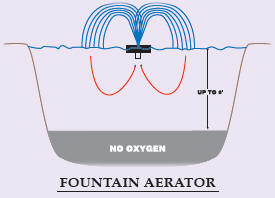 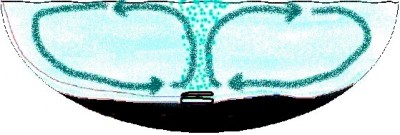
When an aeration system is sized and designed properly the habitat will be provided for beneficial bacteria (aerobic bacteria) and benthic organisms to help clean the lake.
Like anything in nature, all ponds need care. When too much organic matter enters the pond it can cause it to go out of balance or lose its equilibrium. Normally this takes years but can arise over shorter periods. Silt, which is leaf decay, puts stress on the pond, because like anything else, it is competing for oxygen. Eventually it affects the depth and becomes a silent killer.
 The SOLUTION to the problem is diffused oxygen. Oxygen is introduced underwater from the bottom, as the bubbles rise they get bigger and bigger eventually bursting at the surface. The pond is then inoculated with friendly bacteria. The oxygen supports this bacteria and it grows faster than the organic matter can decay. The process starts to reverse and eventually the silt recedes and the aquatic life begin to thrive. Diffused oxygen and bacteria are natural ways of bringing the pond back to good health. The SOLUTION to the problem is diffused oxygen. Oxygen is introduced underwater from the bottom, as the bubbles rise they get bigger and bigger eventually bursting at the surface. The pond is then inoculated with friendly bacteria. The oxygen supports this bacteria and it grows faster than the organic matter can decay. The process starts to reverse and eventually the silt recedes and the aquatic life begin to thrive. Diffused oxygen and bacteria are natural ways of bringing the pond back to good health.
Lake bed Aerators provides ponds and lakes with superior aeration, circulation, and
DE-stratification.
Bottom Aeration will also......
• Prevent fish kill • Eliminates foul odors • Destroys pathogenic bacteria • Oxidizes and removes bottom muck • Reduces midge flies and mosquitoes • Reduces nutrient levels and algae growth • Clarifies and circulates entire water column • Improves fisheries by expanding oxygenated habitat • Increases dissolved oxygen levels from top to bottom • SAFE - no electricity in the water
COMMON QUESTIONS ABOUT AERATION.........
Q: How long will it take for an aeration system to improve my water body?
A: We have seen dramatic results as quickly as 30-days and some lakes take as long as 12 months. This depends on how long it takes to satisfy the Biochemical Oxygen Demand of the water body. By measuring the oxygen levels periodically (in the early morning hours) you will be able to track your results and have a graph indicating the improvements.
Q: How much will it cost for me to run my system?
A: Each system is designed to be operated 24 hours per day 7 days per week, at least during the summer months. The low cost at $0.07 per kilowatt hour is $15/month and the highest cost for our largest system will be $60/month. During the winter, the majority of our customers in the north where their lakes freeze over turn off the system for winter. If you have had winter fish kills in the past, it is recommended that you leave at least a hole open in the ice to allow sun penetration and release of toxic gasses like hydrogen sulfide and carbon dioxides.
Q: Will a surface aerator / floating fountain provide the same results as a bottom aeration system?
A: Surface aeration and floating fountains have their place in water resource enhancement, but when compared to a bottom aeration system, there is no comparison. Simple apples and oranges. A surface system will provide a high amount of oxygen directly around the unit, but not in the lower depths of the lake where the nutrients are being released. Most surface units pump approximately 900 gpm even with a deep draw tube reaching to the lower regions, that is no comparison to a bottom system that will pump approximately 4,000 gpm. Most surface systems suggest 2 hp / acre. We can aerate an acre with as little as 1/4 hp. A great electrical savings. Where surface aerators out perform a bottom system are in shallow areas (4-feet or less) unless you are using one of our water-garden systems designed specifically for shallow areas found in water-gardens. Choose one of these systems for esthetic values, for shallow aeration or emergency aeration.
Q:
How will aeration control my algae problem?
A: First, algae obtain their nutrients from the water column combined with the sun to produce chlorophyll. Aeration when sized properly will bond those nutrients to the bottom sediments. Secondly by circulating the entire volume of the water, planktonic algae (pea green soup-like) is relocated to the lower regions of the water column where the sun can not penetrate. This type of algae will be unable to produce chlorophyll by photosynthesis when this occurs.
The effects on phytoplankton (algae) are less predictable. Destratification may reduce algae through one or more processes: 1) algal cells will be mixed to deeper, darker lake areas as described above, decreasing the cells' time in sunlight and thereby reducing their growth rate, 2) some algae species that tend to sink quickly and need mixing currents to remain suspended (e.g., diatoms) may be favored over more buoyant species such as the more noxious blue-greens, 3) changes in the lake's water chemistry (pH, carbon dioxide, alkalinity) brought about by higher dissolved oxygen levels can lead to a shift from blue-green to less noxious green algae or diatoms, and 4) mixing of algae-eating zooplankton into deeper, darker waters reduces their chances of being eaten by sight-feeding fish; hence, if more zooplankton survive, their consumption of algal cells also may increase.
While algal blooms have been reduced in some lake destratification/circulation projects, in other lakes phytoplankton populations have not changed or have actually increased. For shallow lakes, it's even less likely that complete circulation would result in any of the above-mentioned benefits. This is because algae are less likely to become light-limited in shallow lakes, nor would water chemistry changes be as pronounced
 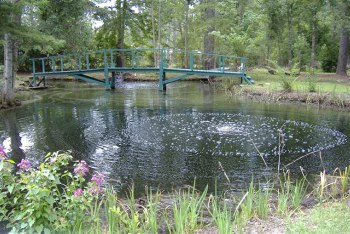 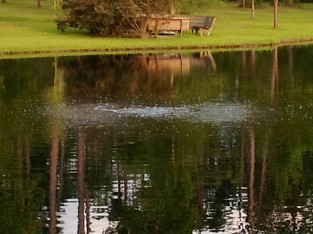
PondSeries™ and Shallow Water Series™
Aeration Systems
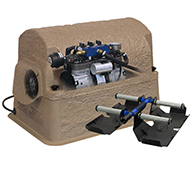 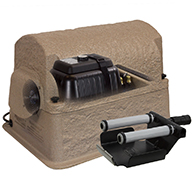
Powerful Aeration For Any Pond
- The Most Quiet
- The Most Efficient
- The Easiest to Install
- Airmax® Composite Cabinet
- SilentAir™ Series Aeration Compressor
- ProAir™ Weighted Diffuse
Southern Floating Fountains & Aeration Systems
or call 985-845-4658
Baton Rouge, Mandeville, Covington, Slidell, Hammond, New Orleans, Louisiana |